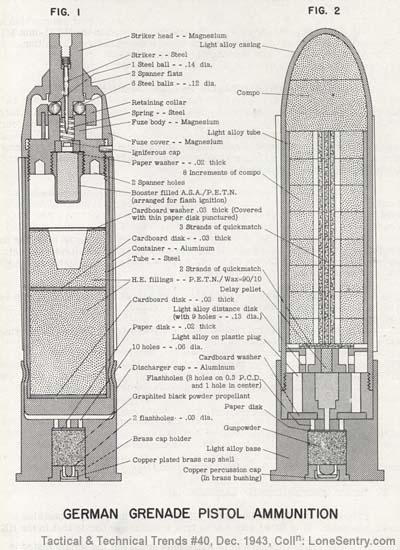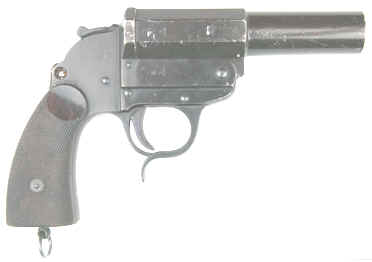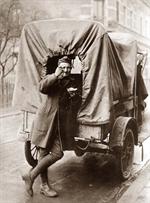This family of single shot pistols evolved from a very simple flare cartrigde launcher to a devoted antipersonnel and antitank devices.


This family of single shot pistols evolved from a very simple flare cartrigde launcher to a devoted antipersonnel and antitank devices.

Lechtpistole.
The Leuchtpistole (“glow pistol”), weighing 1.3 kg, by the company Walther, introduced into service in 1928. It featured a break-action breech and it became the standar flare/signal device of all german military branches.
Lutwaffe Oblt with his LP

The caliber was 27mm and it had a smooth bore.
When the original design was superseded by a construction utilising lighter metal, it not only reduced weight to 0.78 kg, the normal employment was as signal comunication, illumination and marking, but also provoked the engineers to think about other uses for this pistol like the launching of small explosive charges.
The first was the Sprenggranate Leuchtpistole (“explosive-round signal pistol”) or Spgr.LP that was 12.5 cm long. The projectile was proyected by a small black podwer charge and it muzzle speed was merely 60 m/s.
Cartrigde 326 lp and his projectile

Detail on lp 326 grenade.

Given the pistol non-rifle bore it used a fin stabilization and a impact fuse, however, the small warhead with it’s 30g of explosive proved to be too not very efective even at even at close range.
Kampfpistole.
The original Leuchtpistole had a smooth bore that was not very useful for the conceived purposes.
An insert-barrel with a caliber of 23,4mm rifled with 5 grooves right twist was developed to be inserted into the otherwise unchanged Leuchtpistole which by this insertion became a Kampfpistole (“combat pistol”), sometimes also called Kampfpistole Z because of the white “Z” that was painted on the side of the chamber to discern it from the normal Leuchtpistole without the inserted rifled barrel used for firing the combat munitions.
Both the signal and the combat version used spirit level scales that showed the firing angle as an aiming device. The weapon was 24.5 cm long and the barrel had a length of 15.5 cm.
The grooved barrel allowed to shot a large variety of flare, explosive and marking ammunition. so-called [b]Wurfkörpers /b were developed, which were a combination of the head of a handgrenade with a caliber-thick insertion shaft. Obviously thi type of projectile were muzzleloading.
The first model was the Wurfkörper 358 LP that joined the insertion shaft with the warhead of the regular Stielhandgranate (“stick hand grenade”, the famous “potato-masher”). However the warhead proved too heavy which resulted in a too short range.
The second model, the Wurfkörper 361 LP, joined the shaft with a Eierhandgranate (“egg hand grenade”) and proved more practical. Still some refinement was necessary in regard to stability during flight. In this final refinement the thick wooden shaft discarded after launch and left a thin steel tube that stabilized the projectile satisfactorily.
Single handed shooting of the W 361 lp elegant but not very accurate.
Production ran from 1941 to 1942 and 261,788 WK 361 LP were built.
The munition now weighed 0.325 kg, had a length of 22.4 cm and an initial speed of 40m/s and a range of 85m. a later modifcation utilised a plastic shaft that shortened the projectile to 21.8 cm and increased range to almost 100m.
Another projectiles for the Kampfpistole:
Sprenggrenate mit zeitzunder.
This time fuze round teorically allowed the projectile bounce in the ground and exploding in the air. Note the pre-engraver external aluminium rotating band.

. HE (Sprengpatrone für Kampfpistole)
This is a small, nose-fuzed high-explosive round, relying on blast for its effect. However, since the effect is comparatively small it is believed that this round is essentially offensive ammunition, preferably for use in street fighting.
The small prismatic sight on the pistol is graduated to 100 meters (approximately 110 yards) and although tests have shown that longer ranges may be obtained, such shooting is inaccurate.
A general description of the grenade is shown in fig 1 (see accompanying sketches). Other details are:
Weight of complete round Approx 5 ozWeight of projectileApprox 3 1/2 ozType of fillingPETN/Wax (pental erythritoltetranitrate)Weight of filling (2 increments)339 grainsType of propellantGraphited black powderWeight of propellant12 grains*MarkingsBase of cartridge case usually stencilled: “Spr. Z”.
Left HE with time fuze, right HE with impact fuze.

b. Smoke (Nebelpatrone für Kampfpistole)
Externally this is similar to the HE projectile; internally it contains a smoke generator. It is fitted with a nose fuze which is similar to that in the HE projectile, except that there is a charge of gun powder in place of the detonator below the flash cap. The projectile functions on impact. The gunpowder is ignited by the flash cap and blows off the smoke generator, at the same time igniting it. It has been ascertained that the smoke generator may be projected a considerable distance from the point of impact. The projectile may be recognized by the following stencilled marking on the base of the cartridge case: “NEBEL Z”.
c. Indicator (Deutpatrone für Kampfpistole)
This grenade (see fig 2) emits a puff of reddish-brown smoke after it has been in flight for about two seconds. It is similar, externally, to the two grenades described above except for the head which is parabolic. There is no fuze, the smoke train being fired by the flash from the propellant.
Weight of complete round Approx 4 1/2 ozWeight of projectile Approx 3 ozMarking Base of cartridge case stencilled “Deut. Z”.
d. Illuminating Star on Parachute (Fallschirm Leuchtpatrone für Kampfpistole)
This grenade has the general external appearance of the other types. It has a black bakelite head which has a white spot in the center. “F. Leucht. Z” is stencilled on the base of the cartridge case. The base of the projectile has a screwed-on plug which is perforated to hold a gunpowder pellet. Above this is a star to which a parachute is attached. The parachute is towards the forward end of the projectile. The action is as follows: On firing, the flash from the propellant ignites the gunpowder pellet which, after a brief delay, ignites the star. The bakelite head is blown off and the star ejected. The star is of the illuminating type. *This propelling charge appears to be extremely small but the weight stated is correct according to the best available source information.
Some corrections that have reach me by PM.
Hello,
I just read your Leuchtpistolen thread. As far as it is written very well and I enjoy your articles there are some major mistakes.
- The Kampfpistole Z is an airforce developement and the gun was mostly used by paratroopers.
There is only one HE cartridge with two different impact fuzes. No time or delay fuze. There was an trial in early proofings but the project was dropped and never saw service.
The pistol is simply the normal Leuchtpistole with cut in rifling. There is no insert barrel - any other flare ammo or ammo used in the normal Leuchtpistole couldt be fired from the rifled Leuchtpistole Z
( Kampfpistole Z )too.
The cross section drawing of the HE cartridges showes a smoke cartridge at the right site. Not a HE with impact fuze - the composite is smoke composit ignited by a delay powder train from the propelling charge.
- The Wurfkörper 326 LP couldt be used both in the Leuchtpistole and the Kampfpistole Z ( There is a later version of this too )
- The Wurfkörper 358 LP and 361 LP need an smooth insert barrel. This insert barrel looks like an reinforced
steel cartridge case with an hole instead of an primer cap. This “case” (smooth barrel) was inserted into the guns barrel and the gun was closed - the Wurfkörper was inserted from the muzzle( after removing the safety pin) and fixed by a small wire ring spring.
Later this barrel was dropped and the improved Wurfkörper couldt fired from a plain flare gun or Kampfpistole Z.
The first shafts are from aluminum, then made from wood and later from bakelite. These shafts are fixed and they where not discarded.
- These ammo couldt be used in the later intoduced
Leuchtpistole 42 too. This gun was made of pressed sheets and steel and easier to manufacture. There is a rifled version of the Leuchtpistole 42 too.
- The ammo for the Kampfpistole Z couldt not be used in the normal smooth Leuchtpistolen.
- The later introduced Panzerwurfkörper 42 ( AP grenade like a smal Panzerfaust warhead) need an rifled inser barrel. You need this barrel in the normal Leuchtpistole and it couldt be used in the Kampfpistole Z too ( its questionable if it ever hapened , but it couldt). This rifled barrel has a smaller caliber as the rifled barrel of the Kampfpistole Z- be´cause he was inserted into the smooth or rifled barrel) .Because there is an rotation force, the barrel must be fixed. That happens by removing the case extractor. insert the barrel and using a fixing part instead of the extractor… The gun was closed and the Panzerwurfkörper was inserted from the muzzle…
- There are different sorts of sights- if you wanted I send some pictures later.
I research this part of german armament very closely and examine a lot of guns and ammo and have collected a bunch of documents and pics.
As mentioned above you did a great job and so I hope you didnt take this as critism but as a help.
Please feel free to use this info as you like. I will send some pics later.
Best regards
Clearly this theme was beyond my knowledge.
My apologies to everybody for giving wrong information. :neutral:
Sturmpistole.
Given my failure with the kampfpistole I just dare to say that this was a collapsable shoulder stock equipped variant of the early one, it gives a better grip and control of the weapon firing the heavier charges, especially the antitank ones.




And one more picture, the “assault pistol” with a projectile 358Lp inserted.

I am surprised that the alloy this pistol is made from would take that kind of pounding. It is a novel use for an inexpensive device, were they actually effective in use?
With the shoulder stock, it almost looks like something from Man from U.N.C.L.E., or Men in Black… 
According to the new information I ve received from Genkidescan the barrel was not alloy but steel. :roll:
Quote:"1940. Walther break action, single shot signal pistol by Carl Walther Waffenfabrik.
Alloy barrel and frame stamped Waffenfabrik Walther Zella-Mehlis (Thur) WALTHER in a banner and 1940 with various Nazi proof marks.
The breech is opened by a spring loaded trigger guard latch. The grips are brown checkered bakelite attached with a single screw bolt and the butt has a lanyard ring."
Not certain this is the same exact model of pistol, but it is the one I had in mind, I got this from the net.

It was the same model, the non rifled variant.
And this is nasty looking, sturmpistole with a pw antitank round inserted, a tank kill is recorded with this system in 1944.

That is a really nice package there,looks dangerous too. I could use such a thing during traffic jams…
And this the normal Kampfpistole with other hollow charge grenade, man the ammo for this weapon is neverending.
I think this is the HL 62.

Well the flare pistols are made from alluminum alloy and some from zinc.
The rifled Kampfpistole Z used ammo with high/low pressure system. The head of the cartridge case is very solid, with a small powder chamber closed by the primer. Here the powder burns with high pressure and the gas was regulated through nozzles or jets into the low pressure chamber beneath the projectile. ( see the cross section foto )
The Wurfkörper 326 used an nozzle plate and the other ammo was fired with smooth or rifled steel insert barrels.
That is a secret weapon P.K. its true nomenclature was the ICC 62. fired Ice Cream Cones into the enemy positions to distract them before an assault, and since it was Italian Ice Cream, well who could resist.:shock:
and since it was Italian Ice Cream, well who could resist.:shock:

Well the flare pistols are made from alluminum alloy and some from zinc.
The rifled Kampfpistole Z used ammo with high/low pressure system
Excuse me , but I dont fully understand, the barrel was aluminium then?
Yes, sorry I dont explaine it very clear. Leuchtpistole, Kampfpistole Z and Sturmpistole are made totally from alluminum or zinc alloy, only the samll inner parts are from steel. They are blackened by a chemical process and look like steel. If you take a pistol the first time you wonder how light it is.
So the Kampfpistole Z used an ammunition where the high pressure was cope by a solid cartridge head, to that the ammo works with low pressure and low velocity. That is the reason they used steel insert barrels with heavier Wurfkörper of higher velocity.
Well, the steel is always needed , that make a little more confortable if some day I have o shoot this pistol. 
I am posting now the images you send me.
The panzerwurfkorper, antitank HEAT pojectile for sturmpistole.


WK 361 lp.

It’s getting ridicolous! Nobody shoots with a Pistol against a Tank!